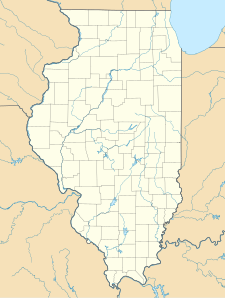Pere Marquette State Park
| Pere Marquette State Park | |
|---|---|
|
IUCN category III (natural monument or feature)
|
|
|
Map of the U.S. state of Illinois showing the location of Pere Marquette State Park
|
|
| Location | Jersey County, Illinois, USA |
| Nearest city | Grafton, Illinois |
| Coordinates | 38°59′57″N 90°31′33″W / 38.99917°N 90.52583°WCoordinates: 38°59′57″N 90°31′33″W / 38.99917°N 90.52583°W |
| Area | 8,050 acres (3,260 ha) |
| Established | 1931 |
| Governing body | Illinois Department of Natural Resources |
|
Pere Marquette State Park Lodge and Cabins
|
|
| Location | Box 158, Grafton, Illinois |
|---|---|
| Area | 16 acres (6.5 ha) |
| MPS | Illinois State Parks Lodges and Cabins TR |
| NRHP Reference # | 85002405 |
| Added to NRHP | March 4, 1985 |
Pere Marquette State Park is an 8,050-acre (3,260 ha) protected area in southwestern Jersey County, Illinois, United States. It is located near the city of Grafton, Illinois, at the confluence of the Mississippi River and the Illinois River. The park is located on Illinois Route 100, which at this location is also part of both the Great River Road and the Meeting of the Great Rivers Scenic Byway. The park is operated and maintained by the Illinois Department of Natural Resources, and is Illinois' largest state park in area. The park is also part of the Confluence Greenway and is at the northwestern end of the 21.5-mile (34.6 km) Sam Vadalabene Bike Trail.
The park was named in honor of Father (Père) Jacques Marquette, a Jesuit priest who was the co-leader, with his comrade Louis Jolliet, of a 1673 voyage of exploration on the Mississippi River. Marquette was the first European to map the mouth of the Illinois River, which he and Joliet used to return from the Mississippi to the Great Lakes.
At the mouth of the Illinois River, the explorers found one of the richest and most densely settled regions of North America, fully utilized by Native Americans of the Illini Confederacy. Large catches of fish, shellfish, and waterbirds were yielded from the rivers and adjacent wetlands. On top of the river bluffs, fertile windblown loess and topsoil could be used to grow corn, beans, and squash.
...
Wikipedia



